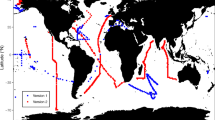Abstract
Datasets on aerosol composition in Southern Ocean air at Cape Grim and Macquarie Island, and rainwater composition at Cape Grim, have been analysed for sea-salt components in order to test the validity of the multiphase autocatalytic halogen activation process proposed initially by Sander and Crutzen (1996) and developed fully for clean marine air by Vogt et al. (1996). Four distinct datasets from the two locations were analysed. All four datasets provided consistent evidence in support of three predictions of the autocatalytic model: (1) overall Cl- deficits in sea-salt aerosol were small, difficult to quantify against analytical uncertainty and at most a few percent; (2) Br- deficits were large, averaging −30% to −50% on an annual basis, with strong seasonality ranging from about −10% in some winter samples to −80% or more in some summer samples; and (3) the Br- and Cl- deficits were clearly linked to the availability of strong, S-acidity in the aerosol, confirming the importance of acid catalysis to the dehalogenation process.
Similar content being viewed by others
References
Ayers, G. P. and Gras, J. L., 1983: The concentration of ammonia in Southern Ocean air, J. Geophys. Res. 88, 10655–10659.
Ayers, G. P., Ivey, J. P., and Goodman, H. S., 1986: Sulfate and methanesulfonate in the maritime aerosol at Cape Grim, Tasmania, J. Atmos. Chem. 4, 173–186.
Ayers, G. P. and Ivey, J. P., 1988: Precipitation composition at Cape Grim, 1977-1985, Tellus 40B, 297–307.
Ayers, G. P., Ivey, J. P., and Gillett, R.W., 1991: Coherence between seasonal cycles of dimethylsulfide, methanesulfonate and sulfate in marine air, Nature 349, 404–406.
Ayers, G. P., Bentley, S. T., Ivey, J. P., and Forgan, B.W., 1995: Dimethylsulfide in marine air at Cape Grim, 41° S, J. Geophys. Res. 100, 21013–21021.
Ayers, G. P., Penkett, S.A., Gillett, R. W., Bandy, B., Galbally, I. E., Meyer, C. P., Elsworth, C. M., Bentley, S.T., and Forgan, B. W., 1996a: The annual cycle of peroxides and ozone in marine air at Cape Grim, Tasmania, J. Atmos. Chem. 23, 221–252.
Ayers, G. P., Cainey, J. M., Granek, H., and Leck, C., 1996b: Dimethylsulfide oxidation and the ratio of methanesulfonate to non sea-salt sulfate in the marine aerosol, J. Atmos. Chem. 25, 307–325.
Ayers, G. P., Granek, H., and Boers, R., 1997a: Ozone in the marine boundary layer at Cape Grim: model simulation, J. Atmos. Chem. 27, 179–195.
Ayers, G. P., Cainey, J. M., and Gillett, R. W., 1997b: Atmospheric sulphur and CCN in marine air in the Southern Hemisphere, Phil. Trans. R. Soc. Lond. B 352, 203–211.
Baines, P. G. and Murray, D., 1994: Modelling of the airflow over Cape Grim, in A. L. Dick and J. L. Gras (eds), Baseline 91, Bureau of Meteorology, Australia, pp. 20–24.
Carpenter, L. J., Monks, P. S., Bandy, B. J., Penkett, S. A., Galbally, I. E., and Meyer, C. P., 1997: A study of peroxy radicals and ozone photochemistry at coastal sites in northern and southern hemispheres, J. Geophys. Res. 102, 25417–25427.
Clarkson, T. S., Martin, R. J., and Rudolph, J., 1997: Ethane and propane in the southern marine troposphere, Atmos. Environ. 22, 3763–3771.
Downey, A., Jasper, J. D., Gras, J. L., and Whittlestone, S., 1990: Lower tropospheric transport over the Southern Ocean, J. Atmos. Chem. 11, 43–68.
Gillett, R. W., Ayers, G. P., Ivey, J. P., and Gras, J.L., 1993: Measurement of dimethylsulfide, sulfur dioxide, methanesulfonic acid and non-sea-salt sulfate at Cape Grim baseline station, in G. Restelli and G. Angeletti (eds), Dimethylsulfide, Oceans, Atmosphere and Climate, Kluwer Academic Publishers, Dordrecht, The Netherlands, pp. 117–128.
Graedel, T. E., and Keene, W. C., 1995: The tropospheric budget of reactive chlorine, Glob. Biogeochem. Cycles 9, 47–78.
Hitchcock, D. R., Spiller, L. L., and Wilson, W. E., 1980: Sulfuric acid aerosols and HCl release in coastal atmospheres: evidence of rapid formation of sulfuric acid particulates, Atmos. Environ. 14, 165–182.
Keene, W. C., Sander, R., Pszenny, A. A. P., Vogt, R., Crutzen, P. J., and Galloway, J. N. 1998: Aerosol pH in the marine boundary layer: A review and model evaluation, J. Aerosol. Sci. 29, 339–356.
Marple, V. A., Rubow, K. L., and Behm, S. M., 1991: A microorifice uniform deposit impactor (MOUDI): Description, calibration and use, Aerosol Sci. and Technol. 14, 434–446.
Millero, F. J., 1974: the physical chemistry of seawater, Ann. Rev. Earth Planet. Sci. 2, 101–150.
Sander, R., and Crutzen, P. J., 1996: Model study indicating halogen activation and ozone destruction in polluted air masses transported to the sea, J. Geophys. Res. 101, 9129–9138.
Tsai, C.-J., and Perng, S.-N., 1998: Artifacts of ionic species for hi-vol PM10 and PM10 dichotomous samplers, Atmos. Environ. 32, 1505–1613.
Twomey, S. A., and Zalabsky, R. A., 1981: Mulitifilter technique for examination of the size distribution of the natural aerosol in the submicrometer range, Environmental Sci. Tech. 15, 177–184.
Vogt, R., Crutzen, P. J., and Sander, S., 1996: A mechanism for halogen release from sea-salt in the remote marine boundary layer, Nature 383, 327–330.
Winklmayr, W., Wang, H-C, and John, W., 1990: Adaptation of the Twomey algorithm to the inversion of cascade impactor data, Aerosol Sci. Tech. 13, 322–331.
Author information
Authors and Affiliations
Rights and permissions
About this article
Cite this article
Ayers, G.P., Gillett, R.W., Cainey, J.M. et al. Chloride and Bromide Loss from Sea-Salt Particles in Southern Ocean Air. Journal of Atmospheric Chemistry 33, 299–319 (1999). https://doi.org/10.1023/A:1006120205159
Issue Date:
DOI: https://doi.org/10.1023/A:1006120205159




